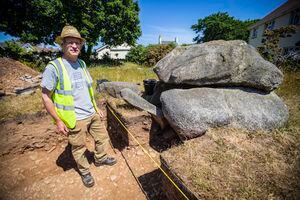‘Too good an opportunity not to unearth Sandy Hook dolmen’
ARCHAEOLOGISTS have begun to unearth one of Guernsey’s most neglected prehistoric monuments for the first time in more than a century.

Guernsey Museums has already been quietly going about its work for three weeks on the site, which is a hidden Bronze Age dolmen, or cist-in-circles, at Sandy Hook, St Sampson’s. It plans to continue throughout the summer, utilising an opportunity described as ‘too good to miss’ as the Guernsey Housing Association makes preparations to build near the site.
States archaeologist Dr Phil de Jersey said the first and only excavation in 1912 focused mainly on the tomb, so this time there was plenty more to investigate.
‘This site is really tucked away and it has been neglected,’ he said.
‘With the GHA’s plans to build near it we thought this would the perfect time to re-investigate what’s here, it is too good an opportunity not to.’
So far one of the trenches to be excavated, the smaller 8m x 2m one that runs to the west of the largest stone cist, has been dug, with the second larger 15m by 5m at a right angle to this running parallel with and immediately adjacent to the south-east boundary concrete wall, yet to be started.
‘Though we haven’t found much so far except for flint, and lots of glass from people disrespecting the site, this is a good chance to confirm or refute things that were said at the first dig,’ said Dr de Jersey.
‘One such thing was that the tomb is situated on a raised beach, which we’ve confirmed is true.
‘This raised beach was formed over 100,000 years ago and then about 4,000-4,500 years ago the tomb was constructed on top of it.
‘It’s more than likely that some of the monument’s big stones have been moved within the last 50 years but it’s really an unusual type of tomb that’s only found in the Channel Islands.’
Its 1912 excavation was directed by Lt-Col T.W.M. de Guerin and it revealed several stone cists, or burial chambers, with associated lines and circles of stones with relatively scarce finds of pottery and flint, but no human remains.
After the dig it was partially backfilled and surrounded by railings, which were later removed.
A gate was installed off the Sandy Hook Estate in 2009 to try to protect the site, which is surrounded by properties on all sides and cannot be seen by the public easily, but now with imminent development of between five and seven dwellings by the GHA, Dr de Jersey hopes the site will become more accessible.
‘There are discussions that we may lose some of the site if the GHA construct access to the development through it,’ he said.
‘It would be unfortunate but the positive to come out of this would be more access and enhancement of the area and encouraging more people to visit.
‘We’re also hoping to do test pits on the GHA land that used to house glasshouses. It’s not likely that we’ll find anything but it’ll be good to check out.’
Three States archaeologists are currently working on the site, following social distancing rules, but it is hoped next week they will be able to include volunteers too.
A full report on the excavation will be submitted to La Societe Guernesiaise for publication as soon as practicable following the end of the work.





